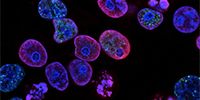Combining Modeling with Experiments for the Study of Cell Mechanosensing

Understanding how mechanical forces affect cell structure and function is critical to a variety of physiological and pathological phenomena, including cell migration, development, wound healing and cancer metastasis. In this project, we will study the mechanisms underlying the response of cells to mechanical forces, by focusing on LIM-domain proteins. We will use a combination of computational modeling and high-resolution molecular imaging of cells subjected to graded force inputs in order to characterize how LIM-domain proteins localize to and repair the cell cytoskeleton after mechanical deformation. Combination of computer modeling with wet lab experiments will allow our team to find important insights into the mechanisms underlying the response of cells to variations in the mechanical environment. By addressing this complex scientific problem, this research will have significance in both the study of fundamental cell physiology and cancer treatment. We will be meeting the four strategic goals of the University of Utah by: (1) bringing together distinct areas of excellence at the U, scientific computing and cell biology; (2) providing occasions for trainees to conduct cross-disciplinary research; (3) increasing public engagement through software development and publications; (4) establishing the foundation for multiple high-impact research proposals.
Current Status
2021-09-13
Abstract:
How cells respond to mechanical forces is important for several activities, including spreading, migration, and invasion. At the leading edge of cells, integrin transmembrane receptors respond to mechanical forces by clustering into adhesions, which link the dynamic actin cytoskeleton to the external environment. How force regulates the assembly of integrin adhesions and how this assembly underlie cell motion remains elusive. With this project we have combined computational modeling with experiments in order to understand how integrin adhesions assemble and elongate, and how this, in turn, regulates the motion of the cell edge. Our results have shown several new insights into force feedbacks between cells and their environment. Actin bundling can elongate nascent adhesions at the base of the cell leading edge, in the absence of cytoskeletal force; actin polymerization against the cell edge regulates the lifetime of nascent integrin-based adhesions, and this, in turn, determines the velocity of the cell edge and its persistence. Our findings contribute to our understanding of the mechanisms underlying force sensing and transmission at the macromolecular and cell levels, with importance in several fields of biophysics and cell biology, including for developing new therapies for diseases in which cell motion plays a role.
Collaborators
Tamara Bidone
College of Engineering
Biomedical Engineering
Project Owner
Laura Hoffman
College of Science
School of Biological Sciences
Michelle Mendoza
School of Medicine
Oncological Sciences
Mark Smith
College of Science
School of Biological Sciences
Project Info
Funded Project Amount$30K
Keywords
LIM-domain; cell biophysics; computational modeling; mechanotransduction, cytoskeleton dynamics
Project Status
Funded 2020
Poster
View poster (pdf)
